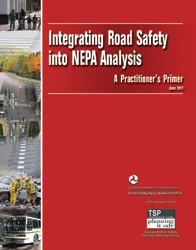U.S. Department of Transportation
Federal Highway Administration
1200 New Jersey Avenue, SE
Washington, DC 20590
202-366-4000
Despite tremendous gains in reducing traffic deaths and injuries, the National Highway Traffic Safety Administration reports over 30,000 people died in traffic crashes in 2009, and another 1.5 million were injured. It is no wonder why the U.S. Department of Transportation considers safety to be its number one priority.
The National Environmental Policy Act (NEPA) process presents a key opportunity to address safety. NEPA requires review of the environmental consequences – including safety impacts – of all Federally funded transportation projects. Taking a proactive approach to traffic safety before and during the NEPA process can save time, money, and most importantly – save lives.
A new tool created by the Federal Highway Administration (FHWA) and the Transportation Safety Planning Working Group (TSPWG), Integrating Road Safety into NEPA Analysis: Practitioner’s Primer, presents a brief introduction to the topic of addressing safety in the NEPA process. It presents practitioners with basic concepts for including meaningful, quantitative analysis of project safety issues and for taking advantage of the latest tools, research, and techniques for improving road safety.
“Safety should be considered first, every time, and at every stage of a project.”
FHWA Office of Safety
The Integrating Road Safety into NEPA Analysis Primer is designed for NEPA practitioners who want to learn more about best practices for analyzing and addressing project safety issues during each stage of the NEPA process. It also is intended to help safety practitioners understand the basics of the NEPA process and where safety considerations can be incorporated. The Primer is organized into easy-to-use sections that walk users through the steps to accomplish the integration. These steps include:
Further information is provided in the Appendices, including links to on-line courses, tools, and research documents, and several case studies describing best practice approaches used by several states.
Safety considerations should be incorporated into each stage of the NEPA process (project scoping, developing the purpose and need statement, alternatives analysis, etc.) and into each type of NEPA document (categorical exclusions (CEs), environmental assessments (EAs), and environmental impact statements (EISs)). Safety also can be considered prior to NEPA, during safety planning processes; and after NEPA, during project construction, operation, and maintenance.
The following figure illustrates the major stages in developing an EIS and summarizes how safety can be incorporated into each stage.

The safety field has reached a new level of sophistication with research and analytical tools practitioners can confidently use to assess and enhance safety beyond minimum requirements. The NEPA process provides an opportunity to capitalize on these advancements.

The Practitioner’s Primer introduces basic concepts to help practitioners and road safety professionals:
To download a copy of the Primer, visit the FHWA web site, or contact Jennifer Warren, Office of Safety, Jennifer.Warren@dot.gov or Susan Grosser, Office of Planning, Susan.Grosser@dot.gov.

